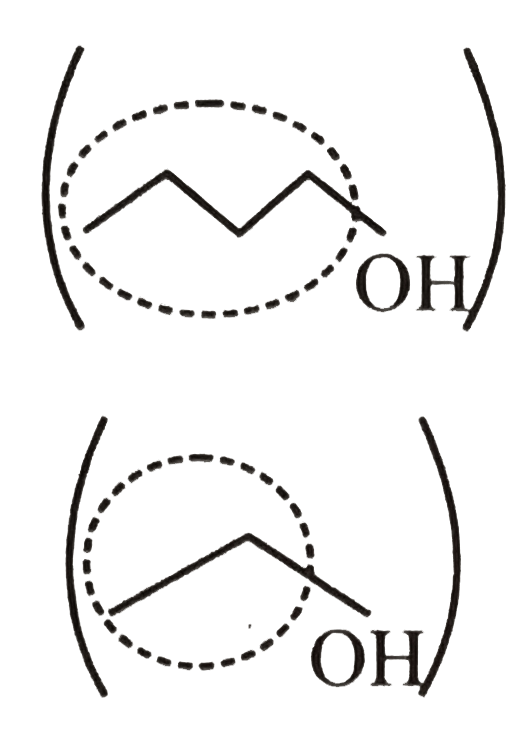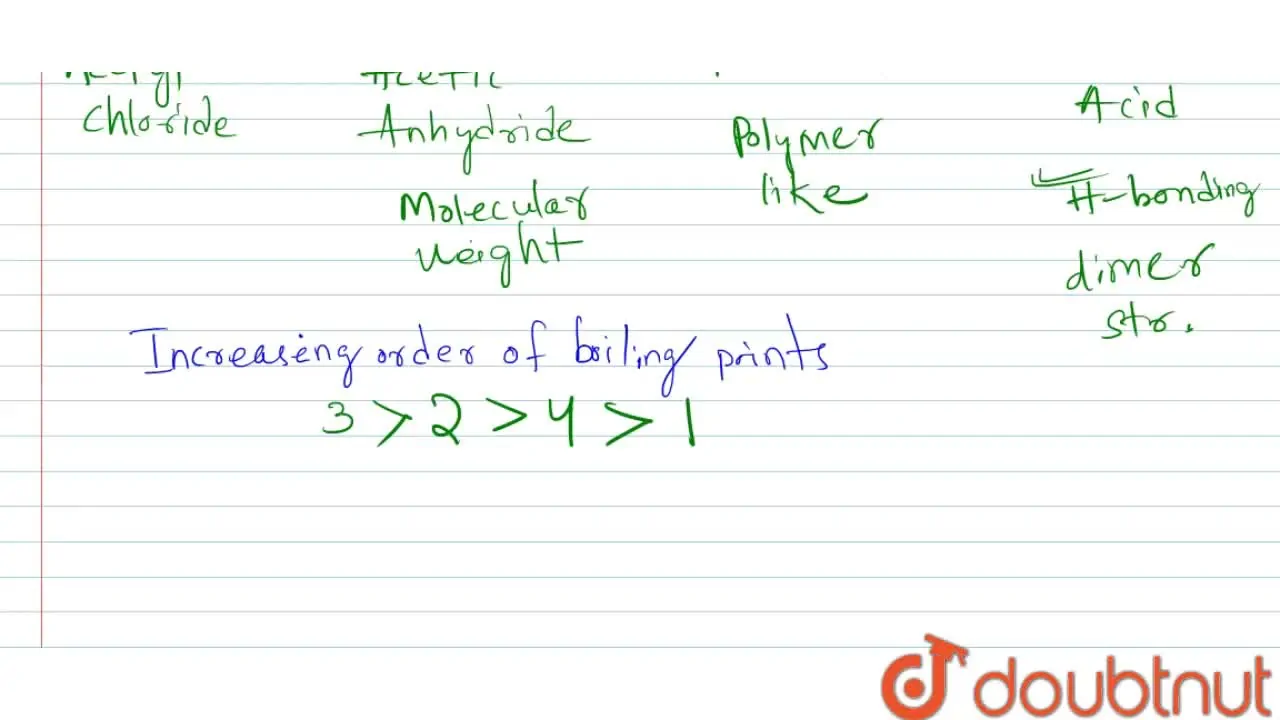I. Arrange the compounds of (a) in the order of decreasing boiling points and (b) in the order of decreasing solubility in water.
(A) (1) Ethanol, (2) Propane, (3) Pentanol
(B) (1) Butane, (2) 1,2,3-Pentane triol, (3) Butyl alcohol
(C) (1) Pentane, (2) Pentanol, (3) Hexanol
II. Arrange the following in the decreasing order of their boiling points.
(A) (1) C3H8, (2) C2H5OH, (3) (CH3)2O, (4) HOH2C−−−−CH2OH
(B) (1) 3-pentanol, (2) n-Pentane, (3) 2,2-Dimethyl propanol, (4) n-Pentanol
III. Arrange the following alcohols (a) in the decreasing order of their boilling points and (b) in the decreasing order of their solubility in water.
(1) n-Butyl alcohol
(2) sec-Butyl alcohol and
(3) tert-Butyl alcohol
IV. Arrange the following compounds in the order of their increasing boiling points.
(1) CH3COC1 , (2) (CH3CO)2O , (3) CH3CONH2 , (4) CH3COOH
I. (A) a. The decreasing order of boiling points is: Pentanol gt Ethanol gt Propane (3 gt 1 gt 2).
Pentanol and ethanol have H-bonding, but molecular mass of pentanol is more than ethanol, so it has high boiling point. Propane has the least boiling point due to non-polar character and weak van der Waals force of attration.
b. The decreasing order of solubility in H2O is: Ethanol gt Pentanol gt Propane (1 gt 3 gt 2).
Both ether and pentanol have H-bonding, but non-Polar part  in pentanol is larger than non-polar part
in pentanol is larger than non-polar part  in ethanol. So ethanol is more solute in H2O than pentanol. Propane is least soluble because of the non-polar character.
in ethanol. So ethanol is more solute in H2O than pentanol. Propane is least soluble because of the non-polar character.
I. (B) a. The decreasing order of boiling point is: 1,2,3-Pentane triol gt Butyl alcohol gt Butane (2 gt 3 gt 1). Due to three (OH) groups in compound (2), it has more H-bonding than in alcohol (3).
b. Decreasing solubility in H2O: (2) gt (3) gt (1). Theere is more H-bonding in compound (2) than in (3), hence it has more solubility in H2O.
I. (C) a. The decreasing order of boiling point is: Hexanol gt Pentanol gt Pentane (3 gt 2 gt 1) Both alcohols have same H-bonding point order is as given above.
b. The decreasing order of solubility in H2O: Pentanol gt Hexnol gt Pentane [same explanation as in I (A) (b) above.]
II. (A) Teh decreasing order of boiling points is: n-Pentanol gt 2,2-Dimethyl propanol

Alcohols (4), (3), and (1) have H-bonding, but n-pentanol is a straight-chain compound and has a larger surface area, (so the highest boiling popint). Alcohol (3) is more sterically hindered than alcohol (1), here it requires more energy to boil off. Therefore, boiling point of alcohol (3) gt alcohol (1).
III. a. The decreasing order of boiling points is: n-Butyl alcohol gt sec-Butyl alcohol gt t-Butyl alcohol (1 gt 2 gt 3).
All alcohol have H-bonding, but alcohol (1) has more surface area. Alchol (2) has less surface area due to breanching, and alcohol (3) has more branching and less surface area then in alcohol (2). Hence, the boiling point order is as given above.
b. Decreasing solubility order in H2O: t-Butyl alcohol gt sec-Butyl alcohol gt n-Butyl alcohol (3 gt 2 gt 1). Lesser the surface area, greater is the solubility in H2O. Hence, the solubiolity order is as given above.
IV. CH3COOH undergoes intermolecular H-bonding while CH3COC1 does not. The boiling point of CH3COOH is higher than of CH3COC1. The molecular mass of (CH3CO)2O is much higher than that of CH3COOH. As a result, (CH3CO)2O has a higher boiling point than that of CH3COOH due to stronger van Waals force of attraction. Like CH3COOH, CH3CONH2 also forms intermolecular H-bonds, whereas in CH3COOH only cyclic dimers are formed. In CH3CONH2, intermolecuar H-bonds lead to the associtation of a number of molecules. As a result, the boiling point of CH3CONH2 is much higher than that of CH3COOH. Further, this higher degree of assocition of CH3CONH2 molecules compensates for the effect of increased molecular size of (CH3CO)2O. Consequently, boiling point of CH3CONH2 is even higher than of (CH3CO)2O. In other words, the boiling points follows the sequence: CH3COCl<CH3COOH<(CH3CO)2O<CH3CONH2
Related Playlists
- BOOK - CENGAGE CHEMISTRY ENGLISHCHAPTER - ALKANES AND CYCLOALKANESEXERCISE - SOLVED EXAMPLES19videos
ALKANES AND CYCLOALKANES
- BOOK - CENGAGE CHEMISTRY ENGLISHCHAPTER - ALKANES AND CYCLOALKANESEXERCISE - EXERCISES24videos
ALKANES AND CYCLOALKANES
- BOOK - CENGAGE CHEMISTRY ENGLISHCHAPTER - ALKENES AND ALKADIENESEXERCISE - Single correct Answer14videos
ALKENES AND ALKADIENES
Similar Questions
(I) Arrange the compounds (a0 in the order of decreasing boilling points and (b) in the order of decreasing solubility in water
(A) (1) Ethanol (2) Propane, (3) PentanolView SolutionArrange the following in the decreasing order of their boiling points: (i) C2H5Br (ii) C2H5Cl (iii) C2H5I
View SolutionArrange the following in the decreasing order of their boiling points:
I. C9H20 II. C8H18
III. View Solution
View SolutionArrange the following in the decreasing order of boiling points :
(i) (1) C3H8
(2) C2H5OH
(3) (CH3)2O
(4) CH2OHCH2OHView SolutionArrange the following alcohols :
In the decreasing order of their boiling points.
(1) n−Butylalcohol
(2) sec−Butylalcohol
(3) tert−Butylalcohol.View SolutionArrange the following compounds in the order of increasing boiling points :
(i) CH3COC1
(ii) (CH3CO)2O
(iii) CH3CONH2
(iv) CH3COOH.View SolutionArrange the following compounds in increasing order of boiling points :
(i) C3H8 (ii) C2H5OH (iii) CH3CHO (iv) CH3COOHView SolutionArrange the following compounds in increasing order of boiling points :
(i) C3H8 (ii) C2H5OH (iii) CH3CHO (iv) CH3COOHView SolutionArrange the following compounds in increasing order of boiling points :
(i) C3H8 (ii) C2H5OH (iii) CH3CHO (iv) CH3COOHView SolutionGive the decreasing order of boiling points of H2O,NH3 and HF
View Solution


